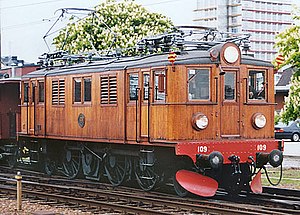SJ D
| D | |||||||||||||||||||||
|---|---|---|---|---|---|---|---|---|---|---|---|---|---|---|---|---|---|---|---|---|---|

A preserved D
|
|||||||||||||||||||||
|
|||||||||||||||||||||
|
|||||||||||||||||||||
|
|||||||||||||||||||||
|
|||||||||||||||||||||
| Type and origin | |
|---|---|
| Power type | Electric |
| Builder | ASEA |
| Build date | 1925-43 |
| Total produced | 333 |
| Specifications | |
|---|---|
| Configuration: |
|
| • UIC | 1'C1' |
| Gauge | 1,435 mm (4 ft 8 1⁄2 in) |
| Wheel diameter | 1,530 mm (60.24 in) |
| Wheelbase | (?) |
| Length | 13,000 mm (42 ft 7 3⁄4 in) over buffers |
| Loco weight | 80.4 tonnes (79.1 long tons; 88.6 short tons) (steel) 79.5 tonnes (78.2 long tons; 87.6 short tons) (wood) |
| Electric system/s | 15 kV 16 2⁄3 Hz AC catenary |
| Current pickup(s) | Pantograph |
| Performance figures | |
|---|---|
| Maximum speed | 70 km/h (43 mph), later 75 km/h (47 mph) (Dg) 75 km/h (47 mph), later 100 km/h (62 mph) (Ds) 100 km/h (62 mph) (Dk, Du, Du2) 110 km/h (68 mph) (Dr2) 120 km/h (75 mph) (Dr) |
| Power output | 1,220 kW (1,640 hp) (Ds, Dg) 1,660 kW (2,230 hp) (Dg, later) 1,470 kW (1,970 hp) (Dk) 1,840 kW (2,470 hp) (Du, Du2) |
| Tractive effort | 141 kN (32,000 lbf) (Ds) 187 kN (42,000 lbf) (Dg, original) 216 kN (49,000 lbf) (Dg, later) 151 kN (34,000 lbf) (Df, original) 161 kN (36,000 lbf) (Df, later) |
| Career | |
|---|---|
| Operators | Statens Järnvägar |
| Numbers | 790-823 883-941 |
| Retired | 1988 |
D is a series of locomotives used by Swedish State Railways (Swedish: Statens Järnvägar, SJ). 333 units were built by ASEA between 1925-43. It was used for both passenger and freight trains until it was taken out of service in 1988.
Though SJs first electric locomotive was the Oa series used on Malmbanan, it was not suitable for use on the main lines, due to low speeds. To solve this problem SJ surveyed a large section of locomotives abroad, before concluding with a design and placed an order with ASEA for 50 units. While ASEA was responsible for the electrical components, ASJ, NOHAB and Motala Verkstad were responsible for the mechanical parts. The first series consisted of two models, the Ds used for express trains and the Dg for freight trains. The former had 90 km/h as maximum speed while Dg only had 70 km/h. The first units were delivered in 1925 and tested on Malmbanan until Västra Stambanan between and Göteborg was finished in 1926. Additional deliveries were made until 333 units had been delivered by 1943. Through the history of production the original wooden body was replaced with a steel construction.
The subdesignation of the D-locomotives follows the function and not the appearance of the locos. To begin with one separated between freight and passenger locomotives, but from the Du-locomotive this separation disappeared since it could haul a freight train at 100 km/h.
Ds was the original D-locomotive made for passenger trains. At first they had maximum speed of 90 km/h, but after 1936 the gearing was changed and speed increased to 100 km/h. Production halted after a more powerful engine was introduced and new locomotives were designated Dk. The Ds locomotives were eventually transformed into Dk locomotives, and the designation Ds disappeared. 159 locos have once had been designated Ds.
Dg was the other original D-locomotive, geared for maximum 70 km/h and optimized for freight trains. From 1936 the max speed was increased to 75 km/h. This type was also later given a more powerful engine, but not a new designation. Thus there have been two types of Dg-locos. During World War II all wooden-bodied examples were rebuilt to Dg. It was in use until 1976. Eventually many Dgs were rebuilt to Du. In total 186 units have had the Dg designation, though not at the same time.
...
Wikipedia
